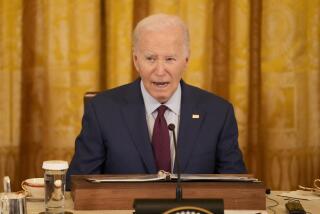Editorial: Trump has some suggestions to help student loan debt, for better and worse
Crooked admissions schemes aren’t the only problem plaguing colleges and their students these days. The cost of a degree from a private college continues to rise, moving well beyond what most families can dream of paying, even with financial aid. Most colleges assume students will take out loans to make ends meet, and they figure that borrowing into their calculations when they make financial “awards.”
As a result, Americans ages 19 to 29 have amassed $1 trillion in debt, according to a February report by the Federal Reserve Bank of New York, mostly in the form of student loans.
The biggest debt holders are not the students who attend the nonprofit and public institutions that dominate in higher education, but those who go to for-profit colleges. These students account for only about 13% of all college students, but they are responsible for more than half of all student loan defaults. One reason for the high level of defaults is that many for-profit colleges promise students far more than they deliver in marketable skills, leaving them without the careers they had expected.
Taxpayers shouldn’t be footing loans for institutions that resemble Trump University.
For better and worse, President Trump addressed both of these issues in a plan for higher education announced Monday. The details are sketchy at this point, but there are enough good ideas to start a discussion in Congress — and enough worrisome elements to merit caution.
Among the most promising requests by the administration — requests, because they would need congressional approval — are the ones that would streamline both the application and repayment for federal student loans. There would be one income-driven repayment plan for each level of higher education: Undergraduates would pay 12.5% of their discretionary income for 15 years; anything unpaid at that point would be forgiven. That’s a reasonable pace, and allows them to finish five years earlier than current plans do. But graduate students would pay for 30 years at the same rate, five years longer than they currently do. Borrowers would also receive more financial aid counseling at the front end, so that they understand the terms of their loans — and also the chances that they won’t be able to pay them back, enabling them to make more informed financial decisions.
Of more concern is the proposal to limit the amount that students can borrow in federal loans for graduate school; there is currently no restriction. The goal is partly to reduce some of the crushing debt — much of which ends up being a load on taxpayers. The administration also hopes that if graduate students can’t borrow up to the full cost of the program, as they can now, graduate schools will have less incentive to continually raise prices.
The effect of this change on students, however, could be drastic, especially for low-income students. Rather than reducing their borrowing, many students and their families would probably turn to private, rather than federal, lenders, receiving less favorable terms. Low-income families might not be able to get these loans at all, limiting the ability of the people who need the most help to attend graduate school.
Reduced federal borrowing could ultimately reduce the load on students, but only if it is accompanied by Pell-type grants for low-income graduate students.
Enter the Fray: First takes on the news of the minute »
Another proposal on the Trump administration’s list would allow Pell grants for people leaving prison, which should have happened long ago. Another would establish short-term programs to train people for vocational certificates and licenses rather than degrees. That’s a fine idea, as long as they’re legitimate job-training institutions, not like the many for-profit colleges that have persuaded students to take loans they can’t afford for programs that don’t lead to jobs.
The majority of loans at for-profit colleges go into default, yet Trump has gone out of his way to free the schools from Obama-era regulations intended to crack down on shady marketing and low performance. Trump’s emphasis on efficient, short-term vocational training is welcome; not everyone needs to go to college. But loans should be provided only for accredited programs with strong records of sending their students on to successful careers. The president surely should know the difference between that and the kinds of programs that should not qualify for federal loans; he ran a real estate training business that closed after paying $25 million to settle lawsuits claiming misleading marketing practices. Taxpayers shouldn’t be footing loans for institutions that resemble Trump University.
Follow the Opinion section on Twitter @latimesopinion and Facebook.
More to Read
A cure for the common opinion
Get thought-provoking perspectives with our weekly newsletter.
You may occasionally receive promotional content from the Los Angeles Times.






